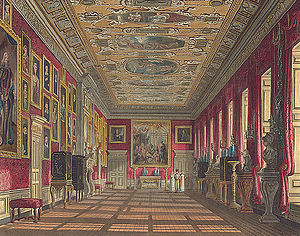
Kensington Palace is a royal residence set in Kensington Gardens in the Royal Borough of Kensington and Chelsea in London, England. It has been a residence of the British Royal Family since the 17th century. Today it is the official residence of The Duke and Duchess of Gloucester; the Duke and Duchess of Kent; and Prince and Princess Michael of Kent.
At the moment, Kensington Palace hosts the exhibition "Diana, Princess of Wales by Mario Testino", open to the public since late November 2005.
History
The original early 17th-century building was constructed in the village of Kensington as Nottingham House for the Earl of Nottingham. It was acquired from his heir, who was Secretary of State to William III in 1689, because the King wanted a residence near London but away from the smoky air of the capital because he was asthmatic. Kensington was at that time a village location outside London, but more accessible than Hampton Court, a water journey on the Thames. A private road was laid out from the Palace to Hyde Park Corner, broad enough for several carriages to travel abreast, part of which survives today as Rotten Row. The palace was improved and extended by Sir Christopher Wren with pavilions attached to each corner of the central block, for it now needed paired Royal Apartments approached by the Great Stairs, a council chamber, and the Chapel Royal. Then, when Wren re-oriented the house to face west, he built north and south wings to flank the approach, made into a proper cour d'honneur, entered through an archway surmounted by a clock tower. Nevertheless, as a private domestic retreat, it was referred to as Kensington House, rather than 'Palace'. The walled kitchen gardens at Kensington House supplied fruits and vegetables for the Court of St. James's.
For seventy years Kensington Palace was the favored residence of British monarchs, although the official seat of the Court was and remains at St. James's which has not been the actual royal residence in London since the 17th century. Queen Mary died of smallpox in Kensington Palace in 1694. In 1702 William suffered a fall from a horse at Hampton Court and was brought to Kensington Palace, where he shortly died. After William III's death the palace became the residence of Queen Anne. Sir John Vanbrugh designed the Orangery for her in 1704 and a magnificent Baroque parterre 30 acre (121,000 m²) garden was laid out by Henry Wise, whose nursery was nearby at Brompton (illustration, left).
George I spent lavishly on new royal apartments from 1718. William Kent painted a staircase and some ceilings. In 1722 he designed the Cupola Room, the principal state room, with feigned coffering in its high coved ceiling; in 1819 the Cupola Room was the site of the christening of Princess Victoria, who had been born at Kensington, in the apartments of the Duke and Duchess of Kent (the actual room being what is now the North Drawing Room).
The last reigning monarch to use Kensington Palace was George II. For his consort, Charles Bridgeman swept away the outmoded parterres and redesigned Kensington Gardens in a form that is still recognizable today: his are The Sepentine, the Basin and the Grand Walk. After George II's death there in the palace in 1760, Kensington Palace was only used for more minor royalty, including the young daughter of the Duke of Kent who was living in the palace with her widowed mother when she was told of her accession to the throne as Queen Victoria. Queen Mary (grandmother of the present Queen) was born at Kensington Palace in 1867.
In 1981 apartments 8 and 9 were combined to create the London residence of the newly married Prince and Princess of Wales, Charles and Diana, and it remained the official residence of Diana, Princess of Wales after her marriage and until the day of her death. Her sons, Prince William and Prince Harry, went to local nursery and pre-preparatory schools in Notting Hill, which is a short drive away. Currently open to the public is Apartment 1A, which belonged to the late Princess Margaret. The tour takes a step back in time and explains the history of Apartment 1A, from the time of the Duke of Sussex through to Princess Louise then to the most recent Princess Margaret and Lord Snowdon. You also get to see, via guided tour only, the invention Lord Snowdon was most proud of-- his "free-standing" extractor fan-- which can be seen in the kitchen.
Nearest Tube: Queensway, Bayswater, High Street Kensington, or (slightly further) Gloucester Road.
The state rooms are managed by the Historic Royal Palaces Agency. The offices and private accommodation areas of the palace remain the responsibility of the Royal Household and are maintained by the Royal Household Property Section.

 Lefthit
Lefthit
No comments:
Post a Comment